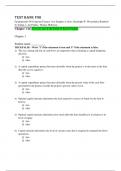Examen
Test Bank for Fundamentals Of Corporate Finance 11ce Stephen A. Ross, Randolph W. Westerfield, Bradford D. Jordan, J. Ari Pandes, Thomas Holloway Chapter 1-26
- Cours
- Établissement
- Book
Test Bank for Fundamentals Of Corporate Finance 11ce Stephen A. Ross, Randolph W. Westerfield, Bradford D. Jordan, J. Ari Pandes, Thomas Holloway Chapter 1-26
[Montrer plus]



